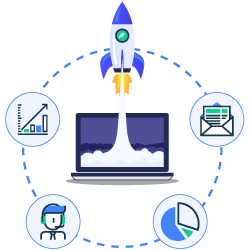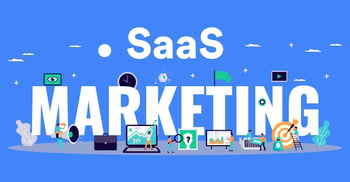
How To Create a Good SaaS Buyer Persona
When you sell video games online, as well as SaaS, software, or digital goods, you must understand who you are selling to. SaaS inbound marketing is used to attract new users to your product and convince them to pay for it. Buyer persona development can help you do just this, but what exactly is it? How do you create one, and where do they fit into your SaaS business? We’re here with some insider knowledge about how you can use personas to take your business to the next level!
What is a SaaS Buyer Persona?
A buyer persona is a fictional representation of what your target customer looks like. This isn’t the same as gathering demographics, as it goes much deeper. It is modeled on how your ideal customer thinks and feels. It goes to the core of who they are and what they want from your product.
Creating a useful persona means tapping into your buyer's mindset. You must uncover their hidden behaviors and motivations. It’s more about finding the why rather than the what. Why do your customers want or need your SaaS product?
With a variety of users out there, it can seem daunting to find your ideal customer. But it’s not that complicated, so let’s get started.

What types of Buyer personas are there?
B2B SaaS Buyer Persona
This persona is a fictional representation of your ideal customer decision-maker. Using these personas gives you focus for your marketing endeavors. It helps you create content that speaks directly to them.
Negative SaaS Buyer Persona
Negative personas represent people who are the least likely to become paying customers. You can use negative buyer personas to refine your understanding of your ideal customer. They can also save resources because you won't waste them on people who will never convert.
Micro SaaS Buyer Persona
A micro buyer persona represents customers who are likely to support a niche product. These are influenced by more subtle features and take longer to market. They can be very useful for audience segmentation and are suitable for businesses with ample resources to cater to each micro persona.
Why do you need to Create a Buyer’s persona?
Personas and inbound marketing strategies are directly connected. Think about it. Inbound marketing is used to create new leads and convert these leads into customers. If you don’t tailor your services to your target customers, the products won’t resonate with them. This decreases the odds of converting a visitor to a fully-fledged customer. Using personas to create your marketing campaigns increases the odds of conversion.
Knowing your customer’s wants and needs is imperative for your SaaS marketing success and should be the first step in any campaign you run.
Let's explore the specific benefits that creating them can hold for your business.

More Cost-Effective
Employing a buyer persona has huge cost-saving potential for your business. If you don’t know who you’re selling to, you’ll waste money on marketing materials that don’t work. Using personas increases your return on investment as these campaigns are more likely to succeed.
Streamlines Content Creation
If there’s one thing all potential customers have in common, it’s that they are looking for something in particular. If you want to catch, keep and convert their attention into sales, you’ll need content that appeals to them. But how do you do this?
Use marketing insights to write compelling copy and answer specific questions. This will lead potential customers deeper into your sales funnel. You’ll want to strategically position this content at particular stages of the buyer journey to move them toward conversion.
No 3rd party vendors. No hidden costs.
No unnecessary complexity.
Just a solution as unique as your business’s needs.
Fine-Tuned Marketing Strategy
Once you know what your customer wants and needs, you’ll be able to craft strategies designed to walk them into (and through) your sales funnel. Using a buyer persona for your marketing strategy helps you to reach the right customers in the right place and in the right way.
Here are some specific ways that you can help optimize your marketing efforts using buyer personas:
Identify the problems potential customers want you to solve.
Indicate which formats, content, and tone will produce the best response.
Show which media channels are best for reaching potential customers.
Highlight the most crucial and detrimental pages to your buying process.
Improves the Product Itself
Using a persona doesn’t just improve the things surrounding your product, like marketing strategies and content. It also enhances the product itself. When you understand exactly what your ideal customer wants, it’s easier to keep adapting your product so it stays relevant.
You’ll have a product that grows and evolves with the customers it’s designed for. As the customer’s wants, needs, and problems change, so will the solutions your product offers to match.
Increases Customer Engagement
By knowing your customers on a personal level, you can connect with real-life potential. When these customers see their concerns being addressed, they are more likely to buy in and trust your product and services. This could be through tailored content or your product development. Whatever the avenue, you can create tangible proof that you are committed to helping them.
Improves Business Communications
Using a buyer persona to inform your communication processes can make your customers feel heard. You’ll know where they’re coming from, and they’ll see that you know where they’re coming from. This promotes customer loyalty which leads to more sales for your business. For example, they help your marketing teams better allocate resources and attract leads. It also helps your sales teams customize sales processes to suit how customers like to be engaged.
Schedule your consultation With Us
How do You Create a Buyer Persona?
Now you know what using a buyer persona can do for your business, how do you go about creating some of your own? Many of us go through life feeling that we’ll never be understood, so it’s no surprise that trying to understand strangers feels daunting. Luckily, it’s a lot easier than you would think!
Here are five simple steps to creating the perfect persona:

Step 1: Research, Research, Research
It seems like an obvious suggestion, but you’d be surprised how many businesses fail to complete comprehensive research. You need to know your customers and their relationship with your product before sketching out an accurate buyer persona.
Let’s take a look at some of the critical research avenues:
Web Tools to Collect Hard Data
There are loads of marketing tools available to help collect and analyze data. You could use Google Analytics to segment your site visitors by keyword usage. This reveals similarities within your search traffic. It also narrows down what your customers were looking for when finding your product.
Customer Data to Identify Trends
Zooming in on the what and why of engagement rates is also paramount when developing a buyer persona. For example, you can look at high-converting blogs to see which topics resonate the strongest with your target audience.
Use the Product Itself to Collect Data
Using your SaaS product is a great way to collect data for persona development. Doing so will provide insight into which features are most popular and which are unused. How are your customers using your product to solve their problems? What parts of your product aren’t helping to problem solve? Understanding where your product is succeeding or failing shows you how your product can be adapted. You can then perfect its fit in your customers' lives.
If your product research shows a pain point that your product fails to solve, this might indicate a recurring problem in your niche. This allows you to step up to the plate and overtake your competitors by improving your SaaS (or even creating a new one entirely) to help solve the problem.
Customer Interviews
After you’ve completed the research outline above, it’s time to talk to your existing users. By questioning actual customers, you can understand firsthand what challenges they face and what they want you to do to help overcome them.
Customer Surveys
Using customer surveys to refine your data is a less resource-intensive research method. There are loads of benefits that come with using customer surveys:
-
It’s less work, so easier to conduct regularly.
-
You can choose specific topics you want insight on.
-
Requesting less information typically earns higher response rates.
-
You can use surveys to test new hypotheses on motivations and needs.
Step 2: Clone Your Most Engaged Users
Once you’ve completed the research stage and analyzed the data, it’s time to get cloning. You’ll probably have a few rough persona versions to work with based on the different users you researched. Start by identifying your most engaged users and look for patterns and similarities between them.
It might be that your most engaged users are those that have already purchased your product. These users have already gone through the buying process and chosen your product; if this is the case, congratulations, you’ve hit the bullseye!
By partnering with PayPro Global, we can ascertain each step these customers took in the buying process and the specific resources that helped them decide. This will give you clear insight into why your product's solution was right for them.

Step 3: Assess Your Persona’s Price Sensitivity
Once you’ve got your persona options, it’s time for step three of the creation process - price point. You must include information about their willingness to pay when molding your personas. At Paypro Global, we can help you experiment with different prices and test your persona's price sensitivity. We can aid you in reaching out to potential users directly and collecting market data.
Step 4: Verify Every Assumption With Data
So you’ve got all the information and made assumptions about your ideal customer’s behaviors - You’re ready to start cutting out a SaaS buyer persona. But before you begin, it's essential that you double-check whether the assumptions you’ve made are correct. You want to find data that proves the validity of every assumption. This data could be anything from internal customer surveys to academic studies.
Step 5: Craft Your Persona Profiles
While refined data and analytics show correlations, they can’t be used practically by your teams. You’ll need to translate this information into a story format that different departments can easily understand and use. This is where the fifth and final step in your SaaS buyer persona development process comes in - crafting profiles.
A profile maps out the information you’ve collected about each persona and collates it into the profile of a fictional person. It’ll indicate a buyer persona’s demographic, purchase behavior, and the unique traits that set it apart from your other personas. These profiles are then used to help develop and improve products and marketing campaigns.
Launching Your Buyer Personas
After completing your buyer persona development, it’s time to put them to use. Your personas should inform every decision about your SaaS and how you market it. Every team member needs to know exactly whom they’re building and marketing the product for.
Here are some sectors in your business where using a SaaS buyer persona is not only useful but essential:

SalesYour sales teams can use personas to better engage and sell your SaaS products. A SaaS buyer persona helps fill in gaps in what the potential customer might be withholding. Your sales team can streamline the sales process and deliver value fast. They’ll save the customer time, making sales more likely.
Customer supportA SaaS buyer persona can be used to identify customers' communication preferences. The information gained from customer support can be used to develop your product further.
Content DevelopmentThere should be a buyer persona at the heart of different pieces of content. Your marketing team should create content that caters to each one you’ve crafted. For example, find out what phrases each persona uses when searching for a solution to their problems and use this in your keyword strategies. Personas need to identify with the language you choose.
KPI Creation KPIs can be used to determine whether a SaaS buyer persona is working. Locating what’s not working shows you if you've made a mistake and prioritized a persona that won’t generate leads.
Steps for Implementing Your Buyer Personas
As we’ve already pointed out, SaaS buyer persona development needs to be the foundation for every choice regarding your SaaS. These personas should be used across your organization, from top to bottom. All elements must be linked to the persona being targeted - from content marketing to social media ads.
Here are four easy steps for implementing your SaaS buyer persona into your business processes:
-
Decide on which persona to target first. Look at your sales team to identify which job titles occur most frequently.
-
Decide which problem to solve first. The first problem you choose will be the first promise that’s sold to potential customers. It will inform all your strategies going forward.
-
Launch your campaign to target a persona. Use the persona and their problem to focus your content. You need to communicate a compelling message centered on a value proposition that the buyer will connect to.
-
Scale to the next SaaS buyer persona. Once you’ve been successful with persona one, it’s time to move on to the second most important persona. Avoid this step until your first persona has achieved lead velocity.

What to Avoid When Using Buyer Personas
Like most things in marketing, there are some things that you should avoid when employing persona strategies. Here are our top 5 tips for avoiding SaaS buyer persona turmoil:
Don’t leave your personas to stagnate; update them regularly.
Involve all your departments in the development process.
Don’t rely on assumptions alone - an assumption without proof is an unreliable bias.
Don’t overdo it - focusing on too many buyer personas dilutes their efficacy.
Ensure your personas are put to practical use - translate the persona into tactics to make money.
Schedule your consultation With Us
Final Thoughts on How To Create a Good SaaS Buyer Persona
Personas guide you in achieving your ultimate goal - converting leads to paying customers, becoming an essential tool when you sell SaaS online. Researching, creating, and using buyer personas helps you identify where your business's power lies. And when you combine your personas with the latest SaaS trends and tools, fantastic results are bound to appear. Reach out to us at PayPro Global today; we would love to help you create a strategy to help your business grow. Combining our knowledge and expertise in global SaaS compliance, tax, and payments with over a decade of experience within the industry, we are the partners you need to drive growth.
FAQ
What is a buyer persona?
The Buyer Persona is a fictitious character that represents your ideal customer. It helps you focus time on qualified prospects while guiding product development to suit the needs of your target customers
Buyers Personas can be created based on data analysis about potential clients' behaviors.
What should be in a buyer persona?
- Name and location
- Their role within the business.
- The value they would gain from your product.
- How they consume information about your product/service
- When and how often to contact them, such as when to send an email, reach out via social media, or call them on the phone.
What is the most common trap you should avoid when developing a customer buyer persona?
Ignoring information about the purchasing process – The customer’s journey does not start at point-of-sale. It starts much earlier and continues well after purchase.
By understanding the customer’s perspective of each step in this journey (the key buying factors), we can make better-informed decisions about how to position ourselves relative to our competitors, as well as what techniques will be most effective for communicating our message within that stage of their journey.
Meir Amzallag
Co-founder and CEO of PayPro Global
Ioana Grigorescu
Content Marketing Manager at PayPro Global
Meir Amzallag
Co-founder and CEO of PayPro Global
Ioana Grigorescu
Content Marketing Manager at PayPro Global
Hanna Barabakh
Hanna Barabakh is a Brand Ambassador at PayPro Global
Adina Cretu
Adina Cretu is a Content Marketing Manager at PayPro Global
Know first. Act fast.
It doesn’t take luck to make it, but it does take knowledge. Be the first to learn the latest industry insights and must know marketing tips and tricks. Sign up and enjoy! Always informed. Never Spammed.







